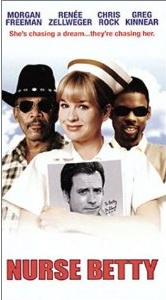Washburn UniversityCenter for Kansas Studies

Nurse Betty
Article written by: Thomas Fox Averill
Nurse Betty has a simple plot. After the murder of her husband in a drug deal gone haywire, Betty (Renee Zellweger) leaves Kansas in search of her soap opera hero, Dr. David Ravell (Greg Kinner). She is pursued by a father/son team of hit men, Charlie (Morgan Freeman) and Wesley (Chris Rock). In her traumatized state, Betty doesn’t know the difference between fantasy and reality, but her crazed innocence fascinates everyone around her. By the time she finally snaps back to reality, she’s managed to win everyone’s heart. She is rescued from evil and lands a role on A Reason to Love. At movie’s end, she sits in Italy ("the Europe"), well-satisfied with herself. The film is finely acted and is winning as serious satire about the thin differences between Hollywood and real life in contemporary culture.
But further, any aficionado of The Wizard of Oz–the film more than the novel–will be head-scratching early in the viewing of Nurse Betty, thinking, “Gee, Toto, I guess we’re not in Nurse Betty anymore.”
Maybe it’s Betty, with her Dorothy innocence, donned in the gingham apron she wears for her job at the Tip Top Café in Fair Oaks, Kansas. Her feet sport red shoes.
Maybe it’s Betty's strong sense that her destiny is somewhere other than Kansas: she stares up at the rainbow mobile over her bed and thinks, “I just know there's something special out there for me.” She is not singing about happy little bluebirds, but close.
Maybe it’s her stormy marriage whose violent end literally spins her into a journey while she’s in a post-traumatic state akin to dream.
Maybe it’s that her journey takes her to LA, a place as oddly fantastical as Oz, during which her confirmed innocence protects her from all evil and corruption.
Maybe it’s her helpfulness to everyone around her–she saves a young man’s life by inserting a tube through a bullet wound in his chest to allow him to breathe. The pretend nurse becomes the real nurse.
Maybe it’s her unlikely allies–a lame-brained, but finally smart, reporter from Kansas, Roy Ostrey (Crispin Glover) and the blustering Kansas Sheriff Ballard (Pruitt Taylor Vince), who turns courageous when necessary.
Maybe it’s the many wizards: seemingly powerful icons who turn out to be just men, after all. Betty’s fixation on Dr. David Ravell stops when she finally sees the actor’s world from behind the scenes–though it’s not Toto who parts the curtain. Betty’s fear of thug Charlie disappears when he reveals how captivated he is by her. His advice is typical Wizard: “You don’t need that doctor. You don't need that actor. You don't need any man. It's not the forties, honey. You don't need anybody. You've got yourself... and that's more than most people can say.” Like the Wizard in the Oz film and book, after giving counsel, Charlie disappears into the heavens (he's shot).
Maybe it’s that final shootout, where the bad guys are eliminated with the help of a fish tank. They don’t exactly melt, but a rush of water is involved.
Finally, maybe it’s that Betty awakes from her stress-induced state and realizes that her dream is both over and yet real. She can be who she is. She has found her place.
The Wizard of Oz/Nurse Betty connection was mentioned in passing in several reviews of the film. The parallels are worth the mention, but viewers should avoid becoming trapped in comparison. Sure, the OR (operating room) of A Reason to Love is as fake as OZ when Dorothy and her friends first seek audience there. And maybe the OR/OZ is intentional in the making of the film.
But the real interest lies in the parallel that might not be so intended. In his storytelling, L. Frank Baum exploited an archetype: the innocent who doggedly pursues a dream and who makes the world a better place, and who finds a place in that better world. That’s Dorothy’s story, and Nurse Betty’s–a story very American, and very Kansas, too.

